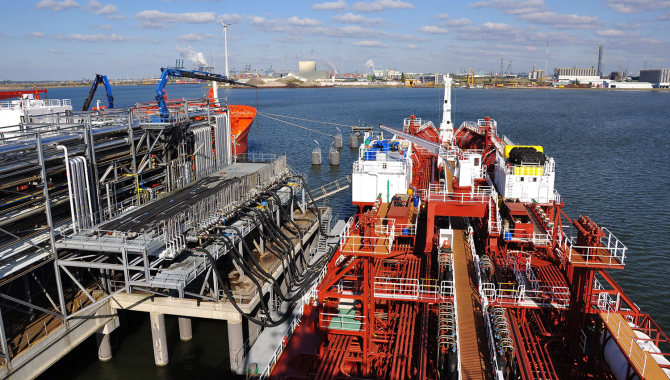
Accidents related to shore pipeline clearing operations are on the rise. Over-pressurization or overfilling of tanks can cause physical damage, pollution and even personal injuries. This article gives an overview of best practices to reduce risks and prevent losses.
Over the last few months, Gard has seen a marked increase in incidents related to the clearing of shore pipelines. The causes can vary: over-pressurization of tanks can cause physical damage, and overfilling of tanks can cause spillage, pollution and personal injuries. In Gard, we have seen examples of all this – including several cases of “near misses” over the past few years.
Risks of pigging and line blowing
The procedures used for clearing shore pipelines will depend on the facilities available at each terminal and the type of cargo loaded. Usually, they involve either line blowing or pigging (see fact box below). Both methods involve transferring large amounts of liquid or gas through the pipelines. Due to the sheer volume being transferred, it is extremely important that this flow is controlled at the manifold with the manifold valve. Moreover, good communication during the entire operation is key to preventing incidents.
Most accidents leading to structural damage to vessel tanks are caused by either too high volume of gas being supplied, too much cargo being pushed into the tank, or that the speed of inflow is too high.
What is line blowing and pigging?
What is line blowing and pigging?
·The purpose of line blowing and pigging is to clear and clean the pipeline as much as possible, to ensure that it is ready for the next operation. This is important to avoid cargo mixture and cargo contamination.
·Clearing of pipelines is done either by line blowing or by pigging. Line blowing involves pushing compressed air or nitrogen through the pipeline to clear it. Pigging involves pushing an object, most often a rubber sphere or cylinder known as a “pig”, through the pipeline by means of a liquid or a compressed gas.Planning and responsibilities
All cargo operations must be carefully planned and documented well in advance of execution. The details of the plans must be discussed with all personnel, both on the ship and at the terminal. The Master should ensure that everyone involved is properly trained and fully aware of the challenges associated with the pipeline clearing operations. A pre-cargo operation meeting between personnel responsible for the operation from ship and terminal should confirm all critical interface parameters. These include:
Hazards to be aware of
·pressure surges in line
·tank over pressurization
·dramatic increase in the filling rate
·cargo tank overflow due to excess cargo
·cargo tank overflow due to entry of compressed gas
Parameters to be discussed in pre-cargo operation meeting
·stages at which the line clearing will be carried out
·notice period required by the ship prior to line clearing operations
·propelling medium to be used
·volume of cargo in the shore pipeline
·time required for a pig to travel along the line
·pressures and venting capacity of the ship’s reception tank
·volume of residual cargo in the line and the amount of ullage space available in the ship’s reception tank
·capacity of the vapour return line to shore
·amendments to the cargo operation plan as a result of pipeline clearing operations, including volumes available for topping off
·communication routines during the entire operation
At the commencement of loading, and at each change of watch or shift, the Responsible Officer and the Terminal Representative should each confirm that the communications system for the control of loading is understood by the personnel assigned to duties during the cargo operation. During the operation, there should be continuous and direct communication between the terminal and the ship until the operation has been completed and all valves have been closed.
Recommendations
In order to minimize risk of over-pressurization:
·Avoid using tanks that are loaded close to 98% as reception tanks for line clearing. Include a safety margin when estimating required ullages for reception tanks to account for potential inaccuracies in the terminal’s declared “pigging quantities”.
·Consider including provisions for a standby cargo tank to be lined up and ready to be opened should the risk of overfill arise.
·Keep manifold valves closed during idle periods. This will prevent accidental over-pressurization due to shore error.
·Ensure that the vapour return line to shore is open during the operation (when available).
·Monitor the manifold pressure closely and throttle the main manifold valve as required. At the start of the pigging operation, the valve should be opened minimally to control the flow and volume of liquid and propellant gas into the nearly full cargo tank. Gard strongly recommends that only properly trained and experienced personnel are assigned duties related to operation of the ship manifold valves.
·Monitor the available amount of cargo tank ullage space and pressure in the tank. If the volume and/or pressure becomes too high, close the manifold valve, and alert the terminal to stop pigging.
·During freezing weather conditions, inspect tank vents (P/V valves) at regular intervals. Some products will freeze and clog the vents thereby creating pressure.
·Close the manifold valves immediately (in agreement with the terminal) once a pig has reached its receiver/trap to avoid compressed propelling gas entering a loaded cargo tank.
·When loading operations are complete, make sure that the manifold valve is fully closed before starting to clear the shoreline.
·Report immediately to the terminal any abnormalities or deviations from normal procedures.
In short, there are several aspects that can reduce the risk of over-pressurization and overfill during clearing of shore pipelines: Increased awareness, training, careful pre-planning with terminal counterparts, and last but not least, good communication between the ship and terminal personnel.
Source: Gard
The opinions expressed herein are the author's and not necessarily those of The Xinde Marine News.
Please Contact Us at:







